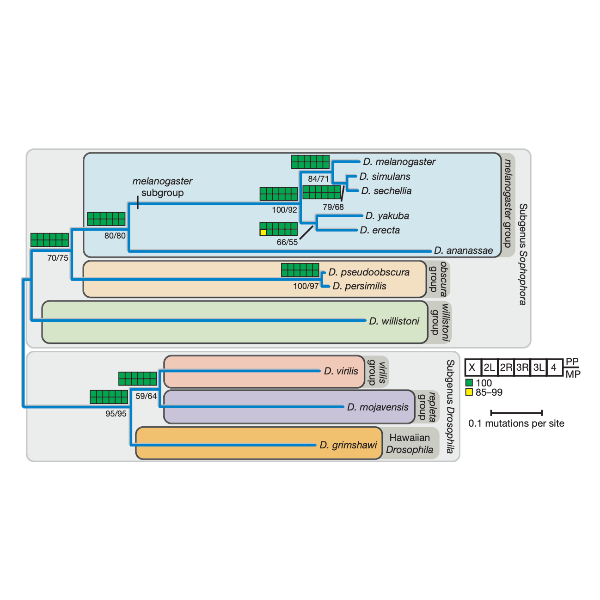
Evolution of genes and genomes on the Drosophila phylogeny.
Clark, Eisen, Smith, Bergman, Oliver, Markow, Kaufman, Kellis, Gelbart, Iyer, Pollard, Sackton, Larracuente, Singh, Abad, Abt, Adryan, Aguade, Akashi, Anderson, Aquadro, Ardell, Arguello, Artieri, Barbash, Barker, Barsanti, Batterham, Batzoglou, Begun, Bhutkar, Blanco, Bosak, Bradley, Brand, Brent, Brooks, Brown, Butlin, Caggese, Calvi, Bernardo, Caspi, Castrezana, Celniker, Chang, Chapple, Chatterji, Chinwalla, Civetta, Clifton, Comeron, Costello, Coyne, Daub, David, Delcher, Delehaunty, Do, Ebling, Edwards, Eickbush, Evans, Filipski, Findeiss, Freyhult, Fulton, Fulton, Garcia, Gardiner, Garfield, Garvin, Gibson, Gilbert, Gnerre, Godfrey, Good, Gotea, Gravely, Greenberg, Griffiths-Jones, Gross, Guigo, Gustafson, Haerty, Hahn, Halligan, Halpern, Halter, Han, Heger, Hillier, Hinrichs, Holmes, Hoskins, Hubisz, Hultmark, Huntley, Jaffe, Jagadeeshan, Jeck, Johnson, Jones, Jordan, Karpen, Kataoka, Keightley, Kheradpour, Kirkness, Koerich, Kristiansen, Kudrna, Kulathinal, Kumar, Kwok, Lander, Langley, Lapoint, Lazzaro, Lee, Levesque, Li, Lin, Lin, Lindblad-Toh, Llopart, Long, Low, Lozovsky, Lu, Luo, Machado, Makalowski, Marzo, Matsuda, Matzkin, McAllister, McBride, McKernan, McKernan, Mendez-Lago, Minx, Mollenhauer, Montooth, Mount, Mu, Myers, Negre, Newfeld, Nielsen, Noor, O'Grady, Pachter, Papaceit, Parisi, Parisi, Parts, Pedersen, Pesole, Phillippy, Ponting, Pop, Porcelli, Powell, Prohaska, Pruitt, Puig, Quesneville, Ram, Rand, Rasmussen, Reed, Reenan, Reily, Remington, Rieger, Ritchie, Robin, Rogers, Rohde, Rozas, Rubenfield, Ruiz, Russo, Salzberg, Sanchez-Gracia, Saranga, Sato, Schaeffer, Schatz, Schlenke, Schwartz, Segarra, Singh, Sirot, Sirota, Sisneros, Smith, Smith, Spieth, Stage, Stark, Stephan, Strausberg, Strempel, Sturgill, Sutton, Sutton, Tao, Teichmann, Tobari, Tomimura, Tsolas, Valente, Venter, Venter, Vicario, Vieira, Vilella, Villasante, Walenz, Wang, Wasserman, Watts, Wilson, Wilson, Wing, Wolfner, Wong, Wong, Wu, Wu, Yamamoto, Yang, Yang, Yorke, Yoshida, Zdobnov, Zhang, Zhang, Zimin, Baldwin, Abdouelleil, Abdulkadir, Abebe, Abera, Abreu, Acer, Aftuck, Alexander, An, Anderson, Anderson, Arachi, Azer, Bachantsang, Barry, Bayul, Berlin, Bessette, Bloom, Blye, Boguslavskiy, Bonnet, Boukhgalter, Bourzgui, Brown, Cahill, Channer, Cheshatsang, Chuda, Citroen, Collymore, Cooke, Costello, D'Aco, Daza, De, DeGray, DeMaso, Dhargay, Dooley, Dooley, Doricent, Dorje, Dorjee, Dupes, Elong, Falk, Farina, Faro, Ferguson, Fisher, Foley, Franke, Friedrich, Gadbois, Gearin, Gearin, Giannoukos, Goode, Graham, Grandbois, Grewal, Gyaltsen, Hafez, Hagos, Hall, Henson, Hollinger, Honan, Huard, Hughes, Hurhula, Husby, Kamat, Kanga, Kashin, Khazanovich, Kisner, Lance, Lara, Lee, Lennon, Letendre, LeVine, Lipovsky, Liu, Liu, Liu, Lokyitsang, Lokyitsang, Lubonja, Lui, MacDonald, Magnisalis, Maru, Matthews, McCusker, McDonough, Mehta, Meldrim, Meneus, Mihai, Mihalev, Mihova, Mittelman, Mlenga, Montmayeur, Mulrain, Navidi, Naylor, Negash, Nguyen, Nguyen, Nicol, Norbu, Norbu, Novod, O'Neill, Osman, Markiewicz, Oyono, Patti, Phunkhang, Pierre, Priest, Raghuraman, Rege, Reyes, Rise, Rogov, Ross, Ryan, Settipalli, Shea, Sherpa, Shi, Shih, Sparrow, Spaulding, Stalker, Stange-Thomann, Stavropoulos, Stone, Strader, Tesfaye, Thomson, Thoulutsang, Thoulutsang, Topham, Topping, Tsamla, Vassiliev, Vo, Wangchuk, Wangdi, Weiand, Wilkinson, Wilson, Yadav, Young, Yu, Zembek, Zhong, Zimmer, Zwirko, Jaffe, Alvarez, Brockman, Butler, Chin, Gnerre, Grabherr, Kleber, Mauceli, MacCallum
2007 Nov 8
Comparative analysis of multiple genomes in a phylogenetic framework dramatically improves the precision and sensitivity of evolutionary inference, producing more robust results than single-genome analyses can provide. The genomes of 12 Drosophila species, ten of which are presented here for the first time (sechellia, simulans, yakuba, erecta, ananassae, persimilis, willistoni, mojavensis, virilis and grimshawi), illustrate how rates and patterns of sequence divergence across taxa can illuminate evolutionary processes on a genomic scale. These genome sequences augment the formidable genetic tools that have made Drosophila melanogaster a pre-eminent model for animal genetics, and will further catalyse fundamental research on mechanisms of development, cell biology, genetics, disease, neurobiology, behaviour, physiology and evolution. Despite remarkable similarities among these Drosophila species, we identified many putatively non-neutral changes in protein-coding genes, non-coding RNA genes, and cis-regulatory regions. These may prove to underlie differences in the ecology and behaviour of these diverse species.